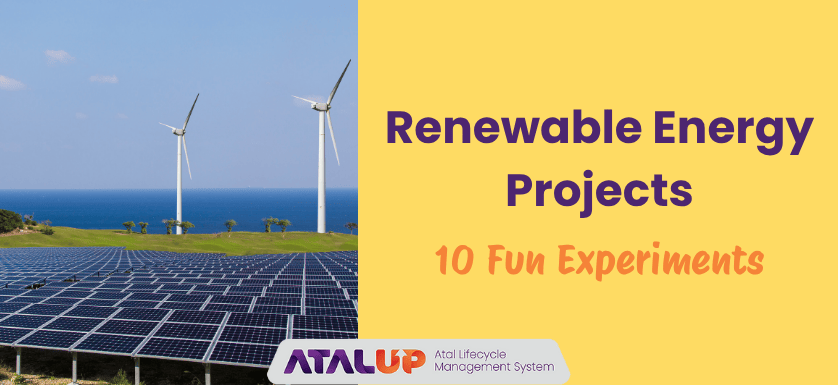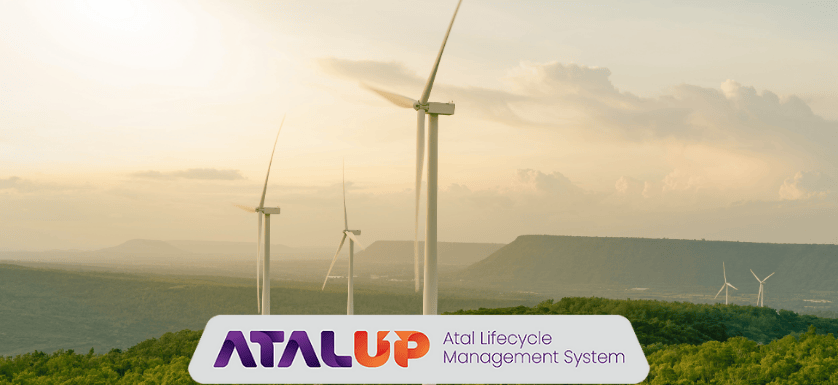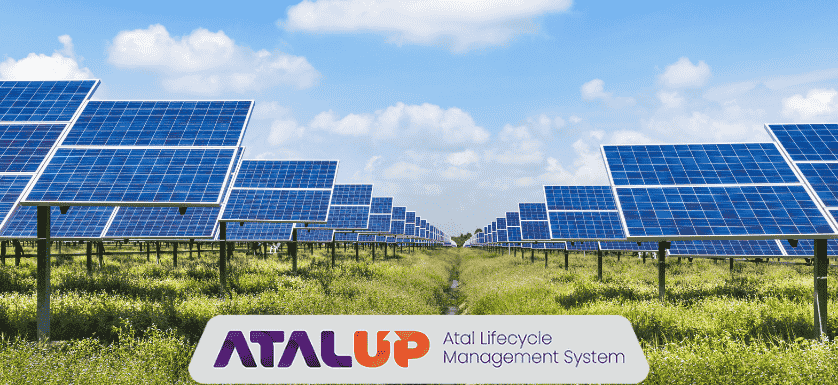
The world is moving fast toward clean and green energy. From solar rooftops to electric cars, renewable energy is becoming a key part of our future. But how do we prepare the next generation for this change? The answer lies in hands-on learning, especially through renewable energy projects.
In this blog, we’ll explore easy, low-cost renewable energy projects for students. Whether you’re a teacher, parent, or school principal, you’ll find ideas to help your students turn into future innovators. And yes, all of this is possible right inside your Atal Tinkering Lab, with support from the ATALUP platform.
What Are Renewable Energy Projects?
Renewable energy projects are simple science models or real working setups that use natural sources like the sun, wind, or water to generate power. These projects help students understand the importance of saving resources and finding sustainable alternatives to fossil fuels.
Examples of renewable energy include:
- Solar energy (sunlight)
- Wind energy
- Hydropower (water)
- Biomass (organic waste)
- Geothermal (heat from the Earth)
For school students, these concepts become more meaningful when they build and test real models in class or through Atal Tinkering Labs. That’s why renewable energy projects for students are gaining popularity in STEM education.
Top 10 Renewable Energy Projects for Students
1. DIY Solar Oven
This project uses the greenhouse effect to cook or heat food using sunlight. Students need a cardboard box, aluminum foil, black paper, and cling wrap. The foil reflects sunlight into the box, while the black paper absorbs heat. The transparent plastic wrap traps the heat inside, raising the internal temperature enough to warm or cook items like marshmallows or nachos. It’s a simple yet powerful way to understand solar thermal energy and sustainability. Students can measure temperature changes and track cooking time, helping them connect energy, environment, and science with daily life in a hands-on way.
2. Mini Wind Turbine Model
Students build a mini wind turbine using cardboard or plastic blades, a DC motor, wires, and a small LED. When the blades rotate, using a fan or natural wind, they spin the motor shaft, generating electricity to light the LED. This project teaches how wind energy is converted into electrical energy through mechanical motion. Students can experiment with blade shapes, angles, and materials to see how design affects efficiency. It helps explain aerodynamics, energy conversion, and basic circuitry in a fun and interactive way that mirrors real-world wind farms.

3. Hand-Crank Generator
In this project, a simple crank mechanism is attached to a motor or dynamo. As students rotate the crank by hand, mechanical energy is converted into electrical energy, which powers a small bulb or buzzer. It demonstrates the direct relationship between effort and output. The faster you turn, the more energy you generate. This activity reinforces the idea of human-powered devices and teaches the basics of energy transformation, torque, and rotational motion. It’s a great model for emergency power generation and understanding the role of dynamos in real applications.
4. Solar-Powered Water Purifier
This setup demonstrates solar-based water distillation. Students place dirty or salty water in a black-bottomed container inside a transparent, closed setup. As sunlight heats the water, it evaporates, condenses on the inner surface, and drips into a clean collection container. This simulates how nature purifies water through the water cycle. It shows how renewable energy can solve real-world problems like access to clean drinking water. The experiment helps students grasp evaporation, condensation, and solar heat absorption in one working model that uses safe, everyday materials.
5. Bicycle-Powered Mobile Charger
This project turns a bicycle into a power generator. Students fit a small dynamo or motor to the wheel, which connects to a voltage regulator and USB port. When the cycle is pedaled, the wheel spins the motor, creating electricity to charge a mobile phone or power bank. It introduces concepts like kinetic energy, voltage regulation, and AC-DC conversion. The project also raises awareness about energy conservation and alternative charging solutions during power cuts or outdoor use. Students get to blend physics, electronics, and sustainability into one exciting outcome.
6. Micro Hydropower Setup
Using a water bottle, small turbine (or bottle cap paddle wheel), and DC motor, students create a system where flowing water spins a rotor, generating electricity. When water flows over the turbine blades, the motion turns the motor shaft, which lights an LED or powers a buzzer. This mimics how large-scale hydropower plants work. The project teaches about potential energy, fluid dynamics, and energy transformation. It’s perfect for understanding renewable energy from rivers or waterfalls and encourages curiosity about rural electricity generation and mini-grid systems.
7. Biogas Model Using Kitchen Waste
Students create a small biogas setup using food waste, a plastic container, pipe, and balloon. The sealed container allows anaerobic digestion of the waste, producing methane gas which inflates the balloon. The setup demonstrates how organic matter can be used to generate clean fuel. It explains decomposition, gas production, and chemical energy stored in waste. Safety precautions must be followed, but the project offers a powerful lesson in waste-to-energy technology and resource recycling. It connects biology, chemistry, and environmental science in a single low-cost model.

8. Solar-Powered Car Prototype
Students build a small car using cardboard or acrylic, plastic wheels, a DC motor, and a mini solar panel. When exposed to sunlight, the panel generates current that powers the motor, making the car move forward. It shows how solar energy is converted directly into kinetic energy. Students can explore variables like panel angle, sunlight intensity, and motor strength. The project builds interest in sustainable mobility, electric vehicles, and green engineering, all using a simple DIY setup. It’s also a fun competition model in STEM exhibitions.
9. Energy from Lemon/Bio-Cells
This project involves using lemons as natural batteries. Students insert zinc and copper nails into a lemon, connect them with wires, and observe voltage using a multimeter or by lighting a small LED. The lemon acts as an electrolyte, and the zinc-copper pair serves as electrodes. Multiple lemons can be connected in series for higher output. It introduces electrochemical reactions, electron flow, and voltage generation using everyday materials. It’s a classic beginner project in renewable energy projects for students and is perfect for understanding the basics of bio-cells and green chemistry.
10. Hybrid Energy House Model (Solar + Wind)
This is an advanced model where students build a house prototype powered by both solar panels and a mini wind turbine. Each power source connects to different functions, lights, fans, or sensors. A switch system can show how energy sources can work independently or together. This project teaches energy diversification, backup systems, and smart energy usage. It reflects how real hybrid energy systems work in smart homes or remote areas. Students also learn basic soldering, load balancing, and circuit planning in a practical way.

Why Renewable Energy Projects Matter in STEM Education
Renewable energy experiments give students a chance to explore science with real-world purpose. They learn how solar panels, windmills, and turbines actually work, not just in theory, but by building working models. These hands-on experiences spark creativity and critical thinking.
In Atal Tinkering Labs (ATLs), students are encouraged to take up such meaningful STEM activities. These labs are designed to foster innovation, and renewable energy projects for students are a great fit. When kids build a solar-powered fan or a wind energy model in their ATL, they’re not just learning, they’re solving tomorrow’s problems today.
This is the core of STEM education: building, testing, and innovating with purpose.
How ATALUP Helps Schools Explore Renewable Energy Projects
ATALUP helps schools apply for the ₹20 lakh government grant to set up Atal Tinkering Labs. But more than that, ATALUP supports schools in running these labs effectively, offering teacher guidance, curriculum alignment, and student tracking.
Through the ATALUP STEM Learning Mobile App, schools get access to ready-to-use project ideas, including renewable energy projects. Students can follow step-by-step activities using household items, no fancy tools needed. Schools can also join the 21-day STEM challenge designed by ATALUP to boost innovation.
Download the app now
Android: Play Store and iPhone: Apple Store
Conclusion
Clean energy is the future, and it starts in the classroom. When students work on renewable energy projects, they don’t just learn, they innovate. By using tools like the ATALUP app and setting up Atal Tinkering Labs, schools can give students the chance to build, explore, and make a real difference.